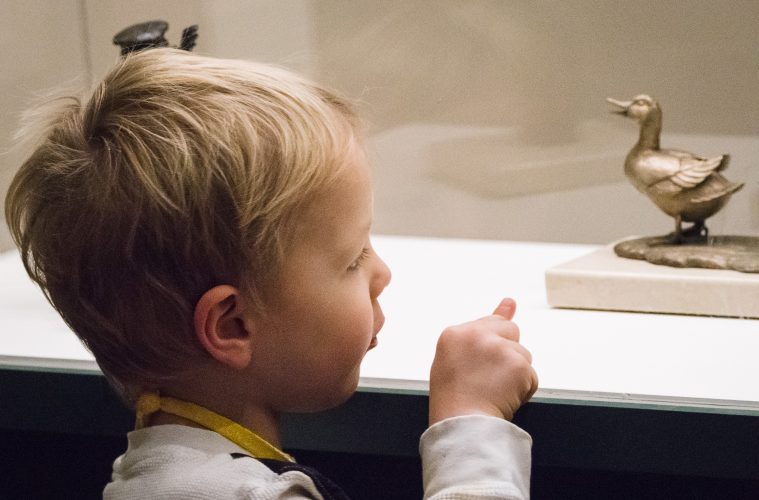Almost 30 years ago, Newton sculptor Nancy Schön created the bronze sculpture that is probably Boston’s most beloved piece of public art. The “Make Way for Ducklings” sculpture depicts Mrs. Mallard and her eight offspring waddling along the pavement of the Public Garden near the corner of Charles and Beacon streets. Mrs. Mallard is 38 inches high, making her the perfect height for children (and the occasional adult) who want to sit on her and pose for the camera. Neighbors seasonally dress them in Santa hats, Red Sox, Celtics, Bruins or Patriots gear, Halloween costumes, or warm scarves. In January of 2017, they all wore tiny pink knitted pussy hats.
Make Way for Ducklings, published by Robert McCloskey in 1941, tells how Mrs. Mallard and her ducklings named Jack, Kack, Lack, Mack, Nack, Ouack, Pack, and Quack negotiate Boston traffic to find happiness in the Public Garden’s lagoon. The book, which has never gone out of print, won the Caldecott Medal in 1942 for McCloskey’s illustrations, executed in charcoal and then lithographed on zinc plates. It is the official children’s book of the Commonwealth of Massachusetts. (Springfield native Dr. Seuss is the official children’s book author.)
It was just one of a series of children’s books that McCloskey wrote and illustrated in the 1940s and ‘50s, several of which also won the Caldecott Medal. In celebration of the 75th anniversary of Make Way for Ducklings, the Museum of Fine Arts, Boston, has mounted an exhibition that will please his books’ fans as well as the parents who read them. Make Way for Ducklings: The Art of Robert McCloskey will run until June 18, 2017, showing where this beloved children’s book illustrator got his inspiration.
Born in Hamilton, Ohio, McCloskey, who lived from 1914 to 2003, came to Boston to attend art school. Examples of his early work shown in the exhibition speak of the influence of Edward Hopper and Thomas Hart Benton. But his paintings did not sell. Famed children’s book editor May Massee counseled him to turn his efforts to juvenile literature. His first effort, Lentil, was a success; he wrote and illustrated seven more children’s books. A number of them are set in coastal Maine, where he and his family summered.
The delightful drawings from Blueberries for Sal line one of the walls at the MFA exhibition. They tell the story of a bear cub and a small child, each following a mother busy harvesting blueberries. Other walls display images from Lentil, Homer Price, and other books, with the delicate, colorful seascapes from Time of Wonder making an especially strong statement.
A room in the center of the larger exhibition space is devoted to Make Way for Ducklings. Its illustrations encircle a wide upholstered bench that holds copies of McCloskey’s beloved children’s books. On a recent afternoon, a woman held a grandson on her lap. As she read, “Mrs. Mallard’s ducklings, named Jack, Kack, Lack, Mack, Nack, Ouack, Pack, and Quack,” he stopped squirming. She read the phrase again and he erupted in giggles, just as children have for the past 75 years.

